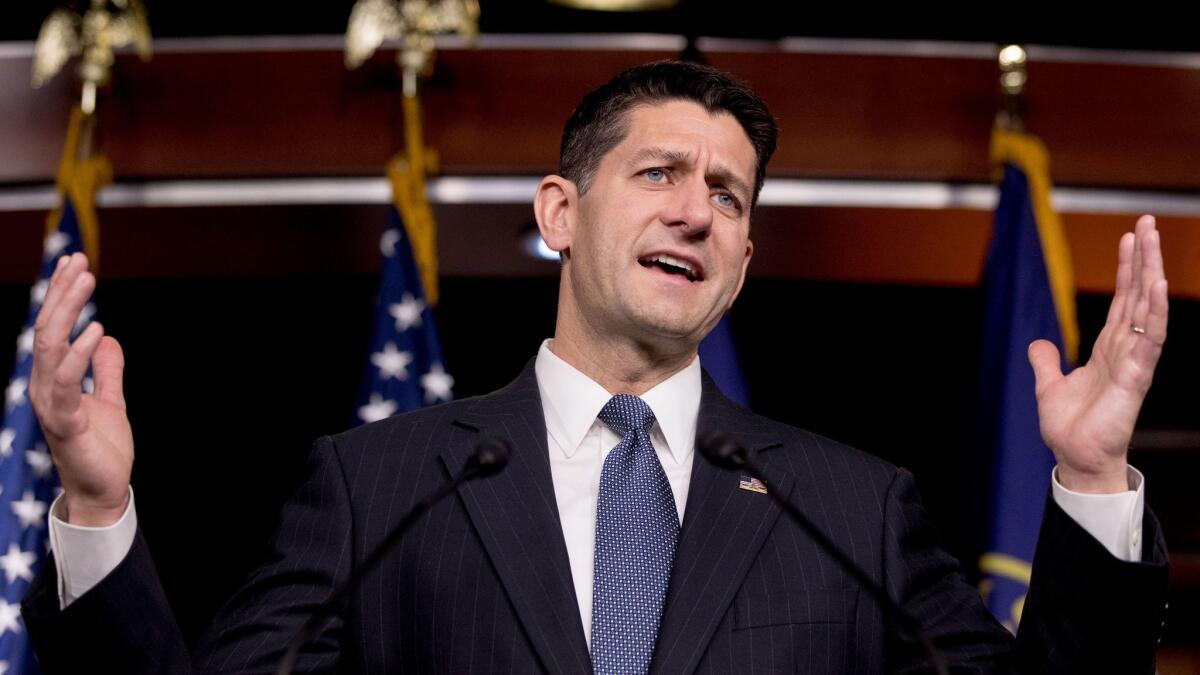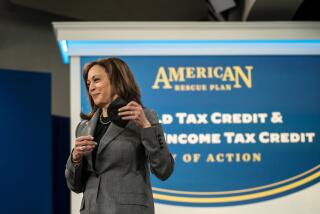Conservatives lament retention of top tax rate in GOP plan, but the wealthy still reap big benefits

- Share via
Reporting from Washington — The decision by House Republican leaders to retain the current top individual tax rate disappointed conservatives who have been gunning for it ever since the 39.6% bracket was reinstated under the Obama administration four years ago.
But while Republicans backtracked on a vow to reduce the rate to 35%, experts said there is still plenty in the party’s tax overhaul bill — including a repeal of the estate and alternative minimum taxes — that would make the richest Americans the overall winners.
“The wealthy are going to do fine,” said Maya MacGuineas, president of the nonpartisan Committee for a Responsible Federal Budget. “This is not even asking them to pay more. This is just slightly reducing the tax cut they’re already in line for under this plan.”
And thanks to another new perk in the bill, many wealthy Americans may find ways to avoid the top rate anyway by funneling their income through business entities. The bill is expected to lower to 25% the top rate paid by so-called pass-through businesses, whose owners file taxes as individuals. Currently, such businesses are taxed at the same rate as individuals, topping at 39.6%
The concession by House GOP bill drafters to retain the top rate is not surprising given the mathematical and political problems they face in crafting the long-awaited tax legislation.
More money is needed to help offset the lost revenue from a deep corporate tax cut and other changes that could swell the federal budget deficit by about $2.2 trillion over the next decade.
Perhaps just as importantly, retaining the highest tax bracket could counter criticisms that the GOP legislation would be a boon to the wealthy.
Republicans were expected to unveil details of the tax plan Thursday after last-minute negotiations over key provisions forced them to postpone the formal rollout by a day.
White House Chief of Staff John Kelly huddled with Republican leaders Tuesday night. And on Wednesday, Marc Short, the White House’s top legislative aide, trekked to Capitol Hill.
Most lawmakers remained unfamiliar with many aspects of the emerging plan and bill drafters had yet to resolve several contested issues. They include whether to lower the amount of tax-deferred savings Americans can put into 401(k) retirement plans and a proposed elimination of the state and local tax deduction, which Northeastern and California lawmakers are fighting.
“I don’t want my state to become a loser” in the bill, Rep. Lee Zeldin (R-N.Y.) said.
Rep. Keven Brady (R-Texas), chairman of the tax-writing House Ways and Means Committee, said the bill would allow people to deduct property taxes, but not state and local income, or sales taxes. Specifics were still being worked out.
Other House members said they expected that there would be more details about the tax legislation Thursday but not the text of the full bill.
“I think we’ll definitely see something,” said Rep. Thomas Massie (R-Ky.) “The question is at what state of finished-ness will it be?”
Trump complicated the effort Wednesday by suggesting Republicans include a repeal of the Obamacare requirement that Americans have health insurance as a way to generate more revenue to offset the tax cuts.
GOP leaders had panned the idea, first floated by a Trump ally, Sen. Tom Cotton (R-Okla.), as unworkable. But it has gained traction among conservatives who favor channeling the $300 billion that is now used to help people buy insurance under the Affordable Care Act into tax cuts. By removing the individual Obamacare mandate, it is expected that fewer people would purchase coverage and therefore federal subsidies would also drop.
“You put that in tax reform, you got a pay-for right there,” said Rep. Mark Meadows (R-N.C.), chairman of the Freedom Caucus.
Keeping the 39.6% tax bracket for high earners “very conceivably could generate a few hundred billion dollars” in extra revenue over the next decade compared with the initial tax outline, MacGuineas said. Under the recently passed budget, the tax bill can add no more than $1.5 trillion to the deficit over that period.
Keeping the 39.6% bracket is “not optimal,” said Rep. Dave Brat (R-Va.). But he said it could be acceptable as part of the broader overhaul. “I’m not queasy yet -- so long as that structure stays in place.”
Other conservatives who have fought for lower taxes also appeared amenable to keeping the rate for the highest earners.“It is not a red line in the sand for many conservatives,” Meadows said.
The 39.6% top rate is historically low. For almost half of the last century since income taxes took effect in the U.S. in 1913, the rate was at least 70%, topping out at 94% at the end of World War II.
The 39.6% figure originated with former President Clinton’s campaign promise to add a 10% surtax on wealthy Americans. The 1993 budget increased the top tax rate to 36% from 31%, then a new bracket was created adding a 3.6% surtax to that level for those earning more than $250,000 a year.
The tax cuts enacted under former President George W. Bush lowered the top rate to 35%. But those cuts expired after a decade. A deal struck by former President Obama and congressional Republicans restored the 39.6% rate in 2013 for couples earning more than $450,000.
The top bracket now is for income of $470,700 or more for a married couple filing jointly after inflation adjustments. Republicans have suggested they may nearly double that income level under their plan, though details have not been released.
But Mark Mazur, director of the nonpartisan Tax Policy Center, said the change might not have a major effect on the wealthiest Americans because much of their earnings is not traditional income.
“For really high-income households, not so much of their income on average comes from salary and wages,” said Mazur, who served as assistant Treasury secretary for tax policy during the Obama administration. “People who are executives or investment managers, most of their income is in the form of tax-deferred capital gains or dividend or income from pass-through businesses.”
Twitter: @JimPuzzanghera
More to Read
Inside the business of entertainment
The Wide Shot brings you news, analysis and insights on everything from streaming wars to production — and what it all means for the future.
You may occasionally receive promotional content from the Los Angeles Times.












